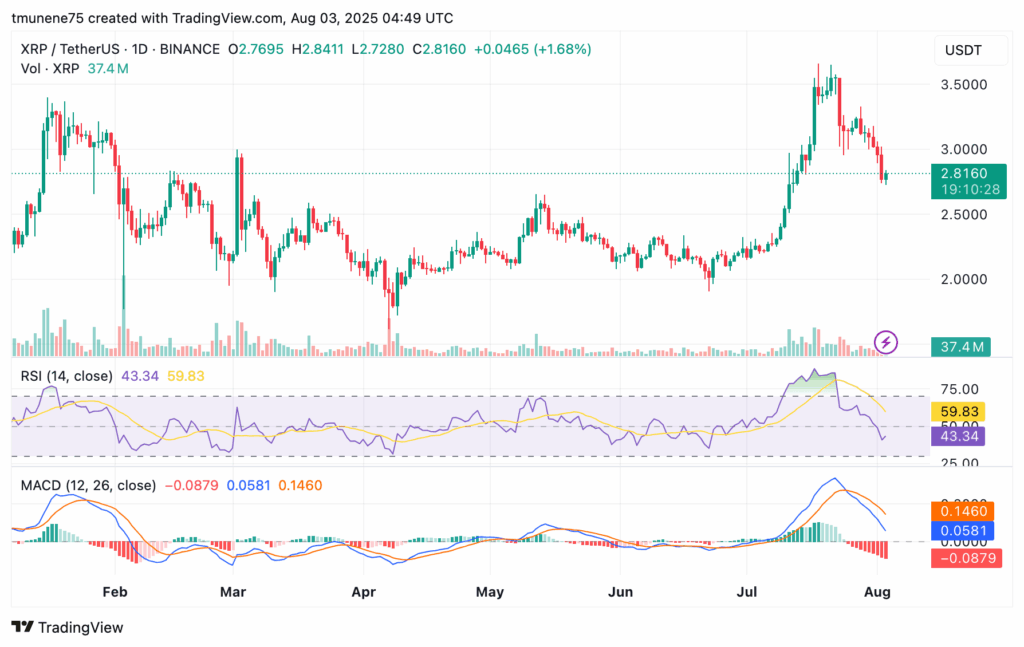XRP is currently correcting after a sharp rally in July, testing crucial support levels between $2.70 and $2.87 as momentum weakens. Holding above $2.60 is vital to maintain a bullish outlook and avoid deeper declines.
-
XRP dropped nearly 20% from its $3.55 peak, now trading around $2.81 amid bearish RSI and MACD signals.
-
Key support zones at $2.70–$2.87 and $2.40–$2.60 will determine short-term price stability.
-
Expert analysis from COINOTAG highlights the importance of $2.60 as a critical level to avoid further downside risks.
XRP correction tests key support between $2.70-$2.87 amid weakening momentum. Stay informed with COINOTAG’s expert analysis and market insights.
What Are the Latest Developments in XRP’s Price Correction?
XRP is undergoing a significant correction after surging to highs above $3.55 in July, marking a 126.43% gain from its previous low near $1.82. The recent pullback erased about 20% of those gains, with XRP currently trading near $2.81. This retracement tests critical support zones and signals a potential shift in short-term momentum.
How Do Technical Indicators Reflect XRP’s Current Momentum?
Technical analysis reveals weakening momentum for XRP. The Relative Strength Index (RSI) has fallen from overbought levels above 70 to 43.35, indicating neutral to mildly bearish conditions. A bearish crossover between the RSI and its moving average at 59.83 supports this trend. Additionally, the MACD line at 0.0581 crossing below the signal line at 0.1460, along with a negative histogram reading of −0.0879, confirms growing bearish pressure. These indicators suggest XRP may face continued downside unless new bullish catalysts emerge.

What Are the Key Support Zones for XRP During This Correction?
XRP is currently testing the $2.70–$2.87 support range, a critical area that could prevent further declines. If this zone fails to hold, the next significant support lies between $2.40 and $2.60, identified by analysts as a potential entry point for renewed buying interest. Below this, the $2.00–$2.20 breakout zone and the major demand area near $1.82–$1.57 serve as deeper support levels historically proven to stabilize price action.

XRP/USDT 1-day price chart, Source: Michael Van de Poppe on X
How Does XRP’s Price Action Reflect Short-Term Weakness Yet Maintain a Bullish Structure?
Despite the current correction, XRP’s broader price structure remains bullish. The asset must hold above $2.60 to avoid a deeper decline toward the $2.00 support zone. Trading volume, currently around 37.4 million, has slightly decreased from July peaks, suggesting a phase of consolidation rather than a full reversal. Stabilization above $2.70 could provide a foundation for recovery, but without renewed buying momentum, XRP may continue drifting lower before testing major demand zones again.

XRP/USDT 1-day price chart, Source: TradingView
| Support Zone | Price Range (USD) | Significance |
|---|---|---|
| Primary Support | $2.70 – $2.87 | Key short-term stability zone |
| Secondary Support | $2.40 – $2.60 | Potential entry point for buyers |
| Major Demand Zone | $1.82 – $1.57 | Strong historical support |
Frequently Asked Questions
What technical indicators suggest XRP’s momentum is weakening?
The RSI has dropped to 43.35 from overbought levels, and the MACD shows a bearish crossover with a negative histogram, signaling declining bullish momentum for XRP.
Why is the $2.70–$2.87 zone crucial for XRP’s price stability?
This zone acts as the first line of defense against further price drops. Holding this range can prevent XRP from falling into deeper support levels, preserving the bullish market structure.
Key Takeaways
- XRP is correcting after a strong July rally: The price dropped nearly 20% from $3.55 highs, testing critical support zones.
- Technical indicators show weakening momentum: RSI and MACD confirm bearish pressure, signaling potential further declines.
- Holding above $2.60 is essential: This level supports the bullish structure; a break could lead to deeper pullbacks toward $2.00 or lower.
Conclusion
XRP’s recent correction highlights the importance of key support levels between $2.70 and $2.87 amid weakening momentum confirmed by technical indicators. While the broader trend remains bullish, sustaining above $2.60 is critical to avoid deeper declines. Traders and investors should monitor these zones closely for signs of stabilization or further downside risk as the market evolves.
